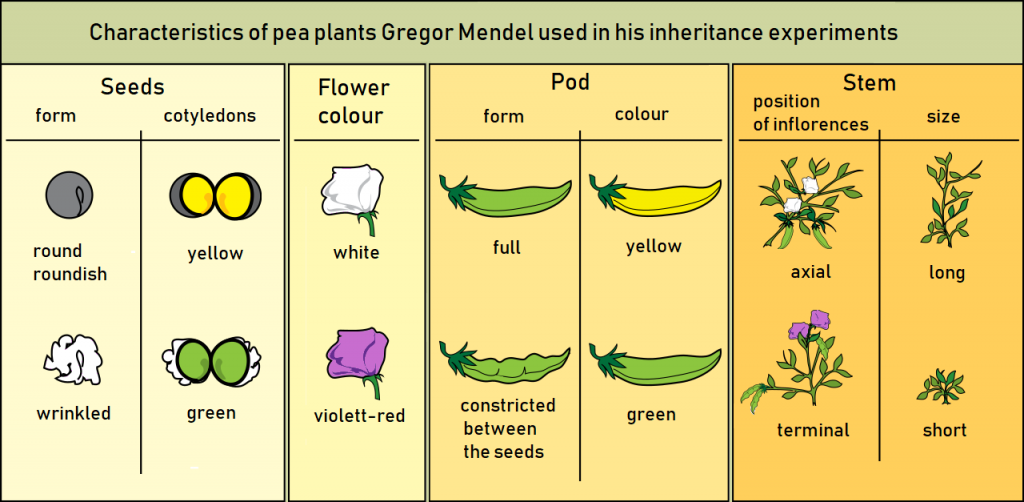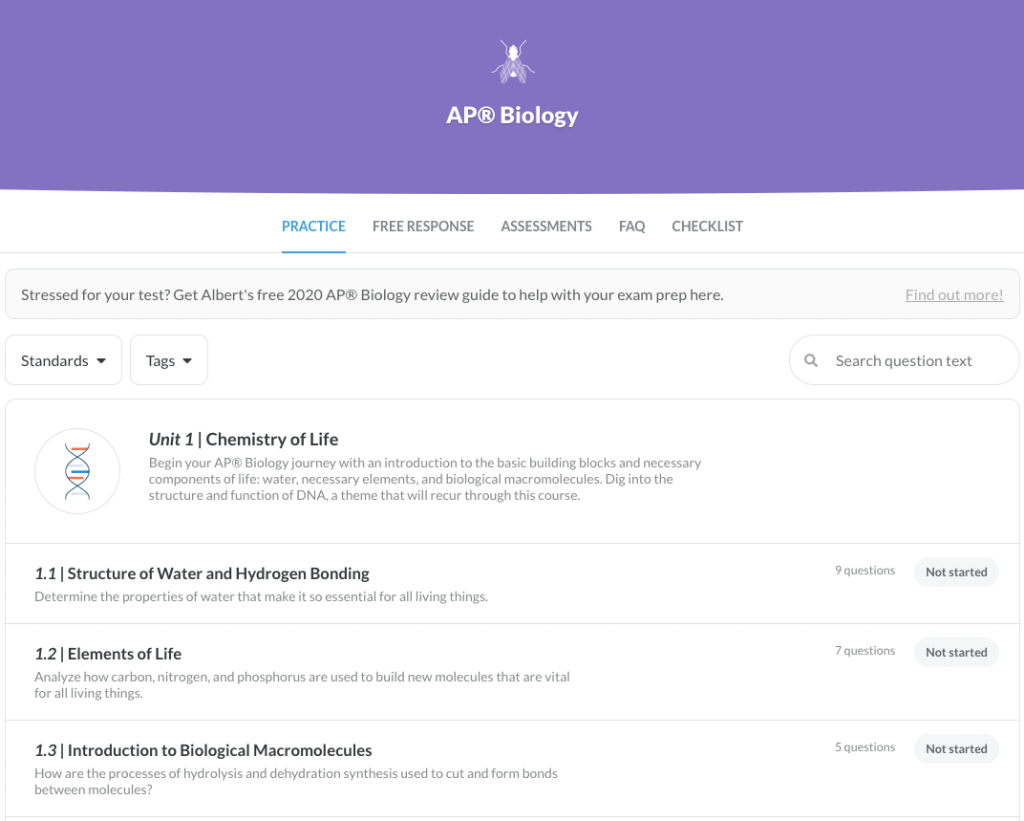“You have your mother’s eyes.” Comparisons like this to a parent’s appearance have been heard by just about everyone—even Harry Potter. But have you ever wondered why all of your siblings got “Dad’s nose” while you have one more like your mother’s? What about those surprising traits that leave families wondering where they came from? The answers aren’t always straightforward, but the study of genetics has helped us to better understand heredity and how it works.
In this AP® Biology Crash Course, we’ll discuss how heredity functions at its most basic level, and then work our way up to more complex types of inheritance.
The Basics
Most people are aware that traits that a person develops throughout life (a muscular build, for example) are not passed down to that person’s children—that would be silly, right? Despite how ridiculous it may sound now, when heredity and evolution were still new ideas, some believed that these traits were heritable.
Here’s a fun story: In the 19th century, French naturalist Jean-Baptiste Lamarck was a strong proponent of this idea that you could pass down traits developed throughout life, arguing that giraffes had gained their long necks by stretching up to reach the leaves, then passing on their stretched necks to their children. Eventually, Lamarck said, the stretched neck was passed down enough times to yield the necks we see today. It might sound like one of those “how the Zebra got his stripes” tales, but at the time, it was a serious scientific hypothesis.
Unfortunately for Jean-Baptiste, the ideas of Lamarckian evolution have not borne out over time. Thanks to a history of diligent experimentation and careful breeding by various researchers, we now know that heritable traits include only those “coded” in an organism’s genes.
Before we get into the details of this Heredity AP® Biology Crash Course, let’s stop a moment to define a few basic genetics terms you’ll need to understand:
- Gene: A gene is a piece of genetic information that “codes” for a certain trait. Genes are made up of two alleles (usually one allele from each parent).
- Allele: An allele is one of two pieces of genetic information that make up a gene. Each allele can be either dominant or recessive. Using the letter “H” for a trait like hair color, a dominant allele would be represented as a capital “H,” while a recessive allele would be represented as a lowercase “h.”
- Locus: A locus is a location where a specific gene is located on a chromosome. The locus of every gene is unique, since two genes cannot occupy the same spot.
- Genotype: The genotype is the genetic “code” for a given trait, which cannot necessarily be determined simply by looking at the organism in question. A dominant hair color, for example, may be produced by either a homozygous dominant (containing two dominant alleles – HH) or heterozygous dominant (containing one dominant and one recessive allele – Hh) genotype.
- Phenotype: The phenotype is the outward appearance of a trait based on the expression of the genotype. The appearance of blue eyes, for example, is a phenotype.
- Generation: A generation is a group of offspring that are at the same level of descent from a common ancestor. A set of parents produce one generation, then the progeny of that generation produce the next generation. A woman, her daughter, and her granddaughter, for example, would represent a span of three generations.

Image Source: Wikimedia Commons
Mendelian Genetics and the Importance of Diversity
One of the first major naturalists to explore heredity at a strongly gene-based level was a 19th century Austrian monk named Gregor Mendel. As an abbot in his monastery, Mendel had a good amount of time and freedom to pursue his curiosities about inheritance and took to breeding garden pea plants with two colors of flowers: white and purple.
By studying the traits of multiple generations, Mendel found that inherited traits were not simply blended together, but rather passed along as separate “particles” of genetic information. These “particles” would eventually come to be known as alleles. Because of his incredible diligence and well-documented early research, many today refer to Mendel as “the father of modern genetics.”
Through his work with pea plants, Mendel determined that heredity follows two primary laws:
- Law of segregation: During the creation of sex cells (or gametes), like eggs and sperm, the two alleles of a gene segregate, and only one allele from each pair goes to each gamete. As a result, when the egg and sperm meet, the offspring will receive one full set of alleles for each of their own genes (one allele from mom, one allele from dad).
- Law of independent assortment: Building off the law of segregation, this law states that during gamete production, alleles arrange themselves independently with alleles from other genes. This means that there is no overall “plan” for allele A from one gene to go to the same gamete as allele A from another gene. Instead, the determination of which allele from each gene goes to a given gamete is completely random.
These laws, often referred to as Mendel’s first and second laws, play a central role in the diversity of life on our planet. Thanks to the incredible number of possible genetic combinations for each species, Earth’s populations are quite resistant to things that might otherwise extinct them.
Imagine for a moment that each human being had one of only five possible sets of genes. If there were an outbreak of a potentially fatal disease, humanity’s survival would depend on at least one of the five types of humans being resistant to the disease. Even if the disease were to be fatal to only one of the five types, that would still mean the death of 1/5 of the population!
This is an extreme example, of course, but it should tell you one thing: in biology, diversity means strength.
Punnett Squares
One of the simplest ways to predict and illustrate the possible genotypes of progeny in a given generation is with a Punnett square. A Punnett square utilizes a grid format to visualize the possible combinations of alleles from the parent organisms.
The possible results of Mendelian pea plant experiments could be shown with Punnett squares as illustrated below.
In the image above, we can see that a homozygous dominant purple plant (PP) is first crossed with a homozygous recessive white plant (pp). The offspring of this cross are four heterozygous dominant plants (Pp), which present with a purple phenotype. This is the first—or F1—generation.
Then, two of the heterozygous dominant offspring are crossed, producing the F2 generation. As shown in the Punnett square, ¾ of the offspring will have purple phenotypes (two heterozygous dominant, one homozygous dominant). Only one of the offspring will have the homozygous recessive genotype and white phenotype.
More Complex Aspects of Heredity
Heredity isn’t all simple pairings of alleles, of course. Some of the more unique aspects of heredity include linked genes, sex-linked traits and non-nuclear inheritance.
Linked genes: Some genes are located very closely together on the same chromosome and are considered linked. In these cases, independent assortment of alleles isn’t quite as independent—instead, alleles from the two linked genes will segregate as a set and go to the same gamete.
Sex-linked traits: Not all of an organism’s characteristics are the result of genes provided by both parents. Some traits are linked to only one of the sex chromosomes (X or Y) and are, therefore, passed on by only one parent of a particular sex. Red-green colorblindness, for example, is found on the X chromosome, of which males have only one. A male who inherits an X chromosome with the genotype for this kind of colorblindness will be born red-green colorblind.
Non-nuclear (or extra-nuclear) inheritance: Transfer of genetic information does sometimes occur outside of the nucleus. Mitochondrial DNA, for example, is inherited from the mother in a process that does not involve chromosomes.
AP® Biology Exam Review & Practice
Here’s what this AP® Biology Crash Course has taught us so far:
- Heritable traits do not include those that were gained during the parent’s lifetime.
- A gene is a piece of genetic information that codes for a specific trait, while an allele is one of the two parts of each gene. Offspring inherit one allele from each parent.
- The actual genetic code for a trait is referred to as its genotype (e.g. Hh for a particular hair color). The observable way in which that code is expressed is referred to as its phenotype (e.g. the physical appearance of having that hair color).
- Gregor Mendel was an Austrian monk whose studies of pea plant crosses helped reveal the nature of genetic information as separate “particles.”
- One way to visualize the possible offspring of a cross between parent organisms is to use a Punnett square. This basic grid method used to show all possible combinations of alleles and determine the overall frequencies of each genotype and phenotype.
- Other, more complex, aspects of heredity include those of linked genes, sex-linked traits, and non-nuclear inheritance.
Think you’re ready to conquer the AP® Biology exam? Try your hand at this heredity practice question:
Who was Gregor Mendel and what did he discover about heredity?
Gregor Mendel was an Austrian monk who bred purple and white pea plants to examine how heritable traits are passed from generation to generation. By noting the color of the offspring of various crosses between plants, Mendel discovered that traits are not blended together, but passed on as “particles” of genetic information.
Need help preparing for your AP® Biology exam?

Albert has hundreds of AP® Biology practice questions, free response, and full-length practice tests to try out.
Are you a teacher or administrator interested in boosting AP® Biology student outcomes?
Learn more about our school licenses here.








